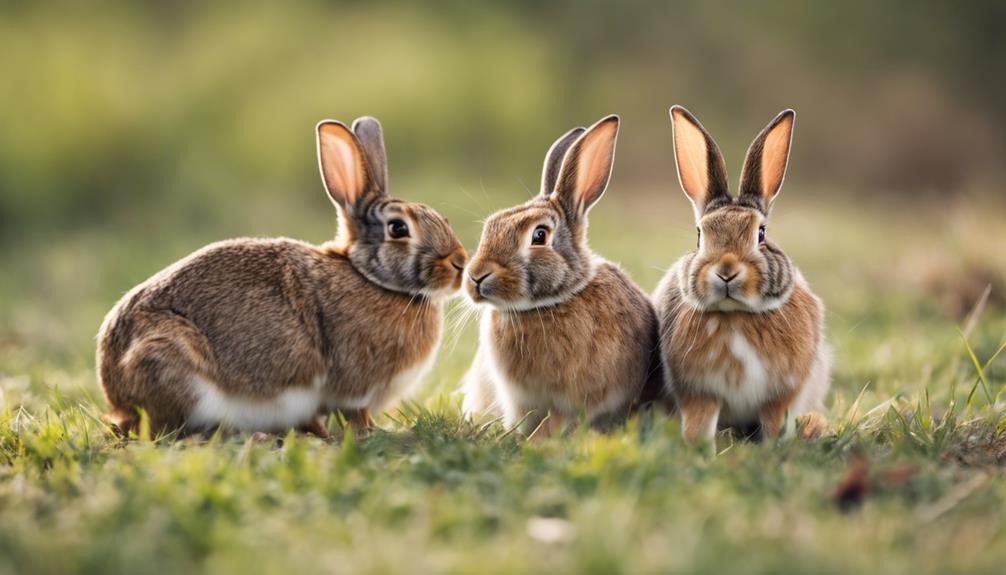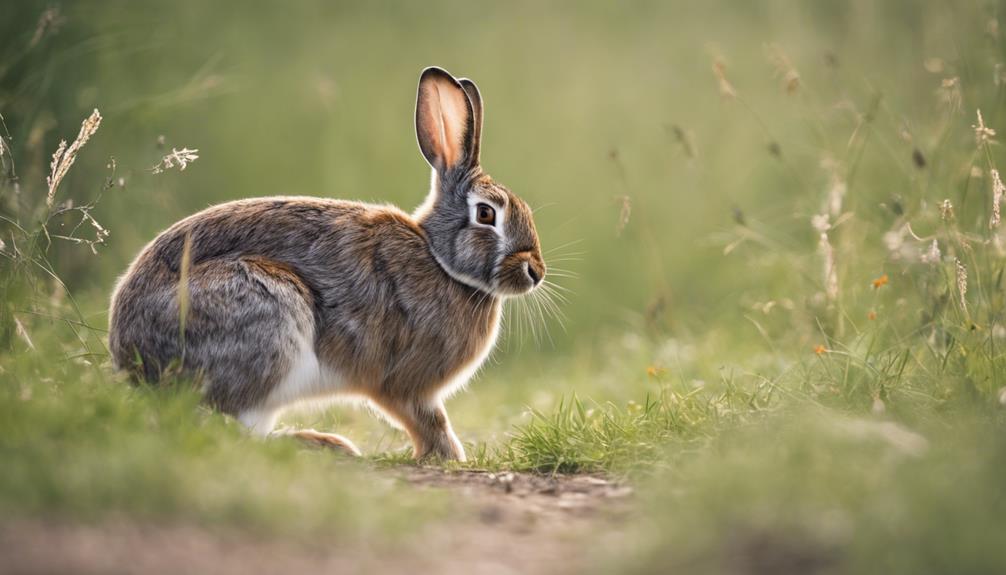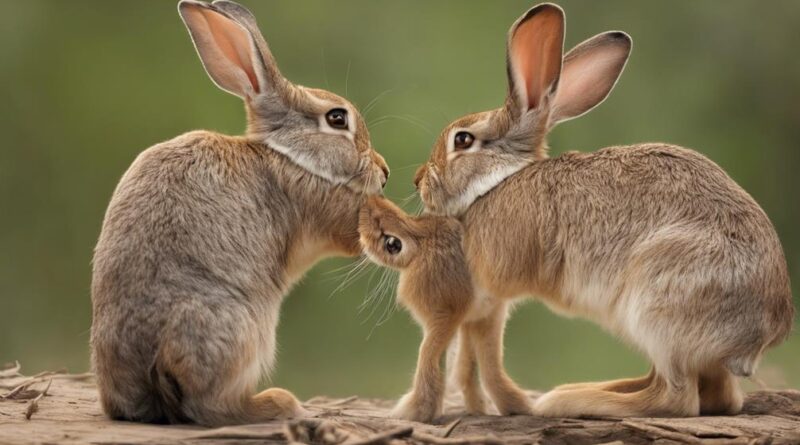Top 10 Behavioral Traits of Wild Rabbits
Wild rabbits display complex social behaviors, forming hierarchies based on dominance. Communication involves thumping, vocalizations, and scent marking to convey emotions. Territoriality is vital, seen through aggressive actions and predator avoidance techniques like camouflage and swift movements. Reproductive success hinges on mating rituals, with induced ovulation in females and competitive behaviors in males. Foraging habits are specialized, enhancing survival with energy-rich foods and storing for scarcity. Daily activity peaks at dawn and dusk, with rest during the day. Hierarchy dynamics within colonies shape social structures. Explore further to uncover more intriguing behavioral traits of wild rabbits.
Social Behavior
Wild rabbits exhibit complex social behavior, forming intricate hierarchies within their warrens to establish dominance and promote group cohesion. Group dynamics play a crucial role in the social structures of wild rabbits. Within a warren, you can observe a dominant hierarchy where the strongest and most assertive rabbits hold the highest positions. These dominant rabbits have access to the best resources, such as food and shelter, while subordinate rabbits follow their lead.
Observing wild rabbits, you may notice various play behaviors that contribute to their social bonding. Play behavior is essential for young rabbits as it helps them develop social skills, establish hierarchies, and learn boundaries.
Grooming rituals are also prevalent among wild rabbits. Grooming not only helps in maintaining hygiene but also serves as a form of social interaction. Through grooming, rabbits strengthen their social bonds, reduce tension within the group, and establish trust among each other.
Territoriality
In the intricate social structures of wild rabbit warrens, territoriality plays a significant role in defining boundaries and resource access among individuals. Wild rabbits exhibit territorial behavior as a means of securing vital resources such as food, shelter, and mates within their environment. This behavior is crucial for their survival and reproductive success.
Aggressive encounters are a common feature of territoriality among wild rabbits. When a rabbit perceives an encroachment on its territory, it may display aggressive behaviors such as chasing, boxing with their forelegs, or vocalizing loudly to deter intruders. These encounters serve to establish dominance and reinforce territorial boundaries within the warren.
Boundary marking is another key aspect of territorial behavior in wild rabbits. They use scent glands located under their chins to mark territory boundaries with their chin gland secretions. By leaving behind olfactory cues, rabbits effectively communicate ownership of a particular area to other individuals, reducing the likelihood of conflicts over territory.
Reproductive Strategies
Reproductive strategies among rabbits involve intricate behaviors and mechanisms aimed at ensuring successful mating and offspring survival. Mating preferences play a crucial role in the reproductive success of rabbits. Female rabbits exhibit a phenomenon known as induced ovulation, where mating stimulates ovulation. This ensures that fertilization only occurs when conditions are optimal for successful reproduction. Male rabbits display competitive mating behaviors, such as fighting with rival males to establish dominance and access to females, increasing their breeding success.
Parental care is essential for offspring survival in rabbits. After a gestation period of about a month, female rabbits give birth to a litter of blind, helpless young called kittens. The mother provides extensive parental care by nursing the kittens and keeping them warm and protected in the burrow. The doe's milk is highly nutritious, crucial for the rapid growth and development of the offspring. In the wild, the mother rabbit will only visit the nest a few times a day to avoid attracting predators, relying on the kittens' well-developed camouflage and scent-masking abilities for protection.
Foraging Habits
Female rabbits exhibit distinct foraging habits that are vital for their survival in the wild, showcasing specialized behaviors in locating and consuming food sources. When it comes to foraging, female rabbits display a remarkable ability to identify and gather a diverse range of vegetation, including grasses, herbs, and even the bark of small shrubs. These foraging habits are crucial for meeting their nutritional needs and sustaining their energy levels in their natural habitat.
One notable foraging behavior observed in female rabbits is their skill in burrow construction. Female rabbits often dig intricate burrow systems not only for shelter and nesting but also for storing food. These burrows serve as a safe space for the rabbits to retreat to when foraging or when they need protection from predators. Additionally, female rabbits engage in food storage behavior by collecting and storing excess food within their burrows. This stored food acts as a crucial reserve that can sustain them during times of scarcity or inclement weather.
Predator Avoidance
To enhance survival chances in the wild, wild rabbits have developed intricate strategies for avoiding predators through their keen senses and swift movements. These strategies include:
- Camouflage Techniques: Wild rabbits have evolved to blend in with their surroundings, utilizing their fur color to match the environment they inhabit. This natural camouflage helps them remain undetected by predators such as foxes, hawks, and owls. By staying inconspicuous, rabbits can reduce the risk of being targeted.
- Escape Routes: Wild rabbits are known for their agility and speed. When faced with a potential threat, they rely on their ability to swiftly dart away from danger. Rabbits are adept at zigzag running to confuse predators, utilizing their quick reflexes to navigate obstacles and evade capture. Additionally, rabbits often seek out burrows or dense vegetation where they can quickly seek shelter if needed.
- Alert System: Wild rabbits have heightened senses that help them detect predators from a distance. Their large ears provide excellent hearing, allowing them to pick up on subtle sounds of approaching danger. Rabbits also have a keen sense of smell and vision, which further aid in detecting potential threats. By remaining vigilant and attentive to their surroundings, rabbits can react promptly to avoid predators effectively.
Nesting Behavior
In response to potential threats, wild rabbits exhibit meticulous nesting behavior as a crucial aspect of their survival strategy in the wilderness. Nesting preferences among wild rabbits often include secluded areas with ample vegetation cover to provide protection from predators and environmental elements. These preferences are driven by the need to create a safe haven for their offspring.
When engaging in nesting behavior, female rabbits showcase remarkable maternal instincts. They meticulously gather nesting materials such as twigs, leaves, grass, and fur to construct a cozy burrow or nest. The construction process is a carefully orchestrated sequence of movements, where the rabbit uses its mouth and forelimbs to arrange the materials into a comfortable and secure space for their young.
Observing wild rabbits during nesting reveals a fascinating display of instinctual behaviors. The female rabbit will line the nest with soft materials like fur from her own body to provide insulation and comfort for the newborns. The nest is strategically positioned to blend with the surroundings, making it less conspicuous to potential predators.
Understanding the intricacies of wild rabbit nesting behavior sheds light on the adaptive strategies these animals employ to ensure the survival of their offspring in the challenging wilderness. Their attention to detail and instinctual drive to create a secure nesting environment exemplify the remarkable behavioral traits that aid in their species' continuation.
Communication Methods

Wild rabbits utilize a variety of distinct communication methods to interact with their environment and fellow rabbits. Understanding these communication methods is crucial in deciphering the complex social interactions within rabbit populations.
Here are three key ways in which wild rabbits communicate:
- Body Language and Vocalizations: Rabbits are adept at using body language to convey messages. For instance, thumping their hind legs on the ground can signal danger to other rabbits, prompting them to flee to safety. Additionally, rabbits use a range of vocalizations including soft purring sounds to express contentment and loud screams when in distress. By combining body movements and vocal cues, rabbits can effectively communicate various emotions and warnings to one another.
- Scent Marking and Grooming: Scent marking is a vital form of communication for rabbits. They have scent glands under their chin, which they use to mark their territory and objects of importance. This helps establish boundaries and communicate ownership within the warren. Grooming also plays a significant role in rabbit communication. Mutual grooming among rabbits not only maintains hygiene but also strengthens social bonds within the group.
Understanding these communication methods sheds light on the intricate ways in which wild rabbits interact and navigate their surroundings.
Mating Rituals
The mating rituals of wild rabbits involve intricate displays of courtship behaviors and communication signals. Courtship displays play a crucial role in mate selection among wild rabbits. Male rabbits often engage in behaviors such as chasing the female, hopping around her, and even leaping into the air in a display of agility to impress potential mates. These actions not only showcase the male's physical prowess but also serve as a way to communicate his suitability as a mate.
Female rabbits, on the other hand, display selective behaviors during courtship. They may observe the male's courtship displays from a distance, assessing his vigor and health. Females are known to prefer males that exhibit strong and confident behaviors during courtship, as these qualities are often indicative of good genetic fitness.
Communication signals are also vital during the mating rituals of wild rabbits. Scent marking, vocalizations, and body postures all play a role in conveying information between potential mates. By interpreting these signals, rabbits can assess each other's readiness to mate and compatibility.
Daily Activity Patterns

During their daily activity patterns, wild rabbits exhibit a consistent routine of feeding, grooming, and exploring their environment. Understanding the intricate behaviors of rabbits can provide valuable insights into their survival strategies.
- Sleep Patterns: Wild rabbits are crepuscular, meaning they're most active during dawn and dusk. During the day, they tend to rest in shallow depressions known as forms, which they line with grass and fur for insulation and comfort. This behavior helps them avoid predators while conserving energy for foraging and other essential activities.
- Social Interactions: Although generally solitary animals, wild rabbits do engage in social interactions, especially during the breeding season. They communicate through various body postures, vocalizations, and scent markings. These interactions are crucial for establishing territories, courtship rituals, and ensuring reproductive success.
- Feeding Schedules and Grooming Routines: Wild rabbits are herbivores with a diet primarily consisting of grasses, clover, and other vegetation. They've specific feeding schedules, with most feeding activities concentrated during their peak activity times at dawn and dusk. Grooming is another essential aspect of their daily routine, helping them maintain their fur cleanliness and regulate body temperature.
Hierarchy Within Colonies
What behavioral cues indicate the hierarchy within rabbit colonies? Dominance dynamics play a crucial role in establishing the social structure within rabbit colonies. Observing social interactions can provide valuable insights into the hierarchy among colony members. Dominance is often displayed through aggressive behaviors such as chasing, mounting, or boxing. The dominant rabbit typically exhibits confident body language, such as standing tall with ears erect and a straight posture, while subordinates may cower or lower their heads in submission.
Hierarchy within rabbit colonies is also evident during feeding times. Dominant rabbits often have priority access to food resources and may defend their feeding areas from subordinates. Submissive rabbits may wait patiently or forage in areas away from dominant individuals to avoid conflict. Dominance can also be seen during grooming sessions, with dominant rabbits receiving grooming from subordinates without reciprocating.
Social interactions such as grooming, playing, and resting together can reinforce the hierarchy within rabbit colonies. Dominant rabbits may initiate or control these interactions, while subordinates comply with their cues. Understanding the dominance dynamics and social interactions within rabbit colonies is essential for comprehending their behavior and social structure in the wild. By observing these behavioral cues, researchers can gain valuable insights into the complex social dynamics of wild rabbit populations.
Frequently Asked Questions
Do Wild Rabbits Have a Preferred Type of Burrow Entrance?
Wild rabbits show a preference for burrow entrances that are well-hidden and camouflaged. This choice aligns with their natural instinct for survival and protection from predators.
By selecting burrow designs that blend seamlessly with their surroundings, wild rabbits enhance their camouflage strategies, making it harder for predators to spot them.
The choice of a preferred burrow entrance reflects the strategic nature of wild rabbits in ensuring their safety and security in their environment.
How Do Rabbits Establish Boundaries in Their Territories?
Rabbits establish boundaries in their territories through territory marking and communication. By scent-marking with their chin glands and urine, they define their space and warn others.
Social hierarchies among rabbits help maintain order, with dominant individuals setting the tone for aggression levels. Aggressive encounters can occur when boundaries are challenged, often involving chases and displays of dominance.
Understanding these behaviors sheds light on how rabbits navigate and defend their territories in the wild.
What Is the Average Distance a Rabbit Travels to Forage?
When you observe wild rabbits foraging, you can notice that they cover an average distance of around 300 meters from their nesting areas. This foraging pattern is essential for their survival as they search for food while being cautious of predators.
Nesting behaviors play a crucial role in establishing safe zones, influencing the frequency and duration of their foraging trips. Social interactions among rabbits also impact their foraging habits, as they may forage together in groups for protection.
Can Rabbits Recognize Specific Predators by Their Scent?
Yes, rabbits can recognize specific predators by their scent. Through their remarkable survival instincts, these animals have developed a keen ability to identify potential threats in their environment.
This predator identification skill is crucial for their predator avoidance behavior. By detecting and reacting to distinct scents associated with predators, rabbits can increase their chances of evading danger and ensuring their safety in the wild.
Do Rabbits Exhibit Mourning Behavior for Deceased Colony Members?
When a rabbit loses a colony member, they may exhibit mourning behaviors that showcase their emotional responses. These grieving rituals can vary but often involve altered social interactions, increased vigilance, and changes in daily routines.
Such colony dynamics highlight the complex social structure and emotional depth within rabbit communities. Observing these mourning behaviors provides insight into the intricate behavioral traits and responses of wild rabbits when faced with loss.
Conclusion
In conclusion, wild rabbits exhibit a complex array of behavioral traits that are essential for their survival in their natural habitats.
From their social interactions to their reproductive strategies and foraging habits, these animals have evolved a variety of ways to thrive in the wild.
By understanding and studying these behavioral traits, researchers can gain valuable insights into the lives of wild rabbits and the intricate dynamics of their colonies.
